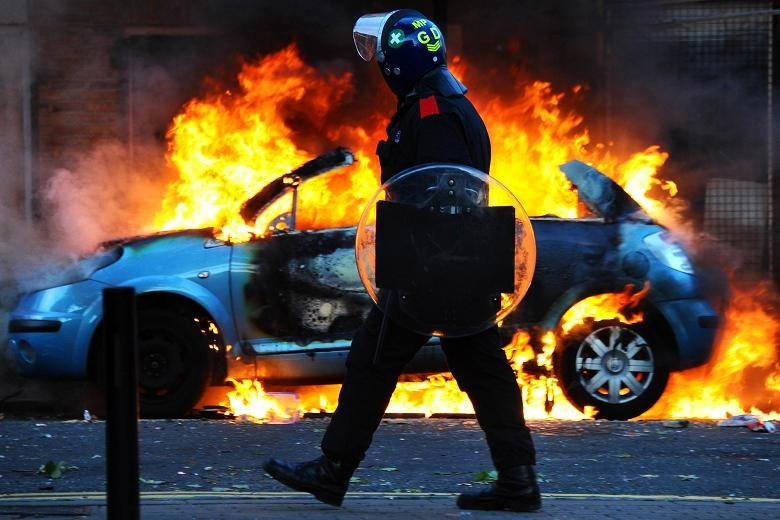3 Myths About Riots
by Callum Cant
30 July 2017

Friday’s small scale anti-police riot in Hackney following the killing of Rashan Charles is provoking the same old responses from the same old people. It was ‘pure criminality’ led by ‘gangs’ of the ‘feral underclass’. The solution? Bring out the water cannons.
But if we look at the research on riots, it’s clear that this is nonsense. Time and time again we hear the same canned opinions of what riots are, what they mean, and how we can solve them. It’s time to get past the myths, and discuss the evidence.
1. Criminality, pure and simple.
In 2011 Labour MP for Tottenham David Lammy was quick to call rioters in his constituency mindless, hedonistic, and nihilistic. David Cameron agreed, and went on to characterise the riots not as a political eruption but as ‘criminality, pure and simple’. Lammy later wrote a book downplaying the role of policing in the riots.
This understanding of the 2011 riots was totally incorrect. Problems with the police and the economy emerge in research as the key motivators of the riots across the country. Guardian/LSE research asked rioters what factors were important or very important in causing the riots: 86% said poverty, and 85% said policing. The next two results on the list were government policy (80%) and unemployment (79%). Analysis carried out by researchers at Oxford showed that, in London, the more deprived and anti-police an area was, the more likely those arrested and charged for rioting were to live there.
This is the reality expressed by Lammy’s predecessor as MP for Tottenham Bernie Grant, who – reacting to the 1985 riots – said that police got ‘a bloody good hiding’, and by Dianne Abbot, whose response to yesterday’s events in her constituency recognised ‘understandable anger and upset’ at the killing of Rashan Charles.
Riots are certainly criminal, but they are also political. They are created by policing and poverty, and take the form of an attack against the perceived sources of these problems. You may disagree with the method, but you have to recognise the motivation.
2. A feral underclass of gangs in a state of moral decline.
The final report published by the Riots Communities and Victims Panel concluded that the 2011 riots were caused by family breakdown, and schools not building strength of character. Their resulting recommendations reflected these myths, proposing (with a hint of fascism) that local authorities establish ‘uniformed groups’ like army cadets, and schools teach morality to pupils and set up ‘business ambassadors’ to promote youth employment.
This narrative was reflected by Guardian/ICM polling, which found that when asked what were the important or very important causes of the 2011 riots, the top four answers were criminality (86%), poor parenting (86%), moral decline (82%), and greed (77%). Calling the rioters a ‘feral underclass’, as justice secretary Kenneth Clark did in an article for the Guardian, seemed like an accurate reflection of the popular mood.
When David Starkey claimed that the ‘whites have become black’, that is to say, the working class have become the underclass, he was only being particularly obvious in expressing the racism and class bigotry that was implicit in these kind of arguments. Gang-phobia was a riot myth that also gained a lot of public support. When Guardian/LSE researchers asked rioters and the general public if gangs had caused the 2011 riots, the gap between myth and reality was clear. Whilst 75% of the general public said it was an important or very important factor, only 32% of rioters agreed. This myth is now being recycled to explain events in Hackney: it was hard to miss the Evening Standard headline describing a crowd of young, mostly black protesters as a ‘gang’.
By 2012 the government was rowing back on its feral underclass analysis, as it turned out that only 19% of those convicted were ‘gang members’. But the accuracy of the myth is obviously not the point. Instead, it’s repeated because it’s convenient for those with something to gain from defending the status quo: rather than recognising that there are bad conditions which people are rioting against, they can say that it is the people themselves that are bad.
In the end, the feral underclass myth comes down to an attempt to marginalise rioting sectors of the working class. This is necessary because, above all, what the state and capital need to avoid is the rest of the class recognising themselves in the rioter, and deciding to join in.
3. It’s a one off.
In 2011 81% of participants polled by the Guardian/LSE predicted riots would happen again. Last night they were proven right, though on a much smaller scale than in 2011. The underlying dynamics producing riots won’t go away as a result of authoritarian responses. Unless fundamental questions of social antagonism around class and race are addressed, riots look set to become an increasingly common part of working class movements.
Capitalism is what is producing riots, it won’t be able to solve them. As Fred Hampton once said, you’ve got to fight fire with water.